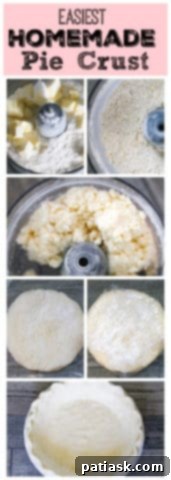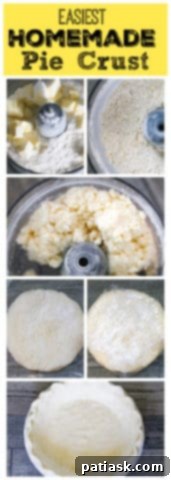Craving a classic, melt-in-your-mouth pie? Our delightful, homemade Easy Homemade Pie Crust is your secret weapon, promising a gorgeous golden hue, incredibly tender, flaky layers, and a rich, buttery flavor that elevates any filling. Forget store-bought shortcuts; with this simple, foolproof recipe, you’ll be crafting perfect pie crusts right in your own kitchen with confidence and ease!
If you’re already dreaming of delectable pies, you’ll love exploring some of our other cherished recipes. Perfect your baking skills with our Creamy Custard Pie, whip up adorable Easy Mini Pumpkin Pies, indulge in the unique Amish Peanut Butter Cream Pie, or satisfy a sweet tooth with our decadent Reese’s Peanut Butter Pie. Each starts with a stellar crust, and ours is the best place to begin!

Why This Easy Pie Crust Recipe Will Become Your Go-To
Many home bakers find the idea of making pie dough from scratch intimidating. If you’ve ever felt overwhelmed by the thought of a tough, crumbly, or difficult-to-handle pie dough, this recipe is designed to banish those fears forever. Our incredibly user-friendly method leverages the power of a food processor, transforming what seems like a complex task into a quick and easy process. The result is a wonderfully pliable dough that’s a joy to work with and bakes up into a visually stunning, perfectly flaky crust every time.
Trust me, I was once one of those apprehensive bakers who avoided homemade pie crusts. But discovering this technique was a game-changer! Not only does it yield consistently beautiful results, but it also makes the process so convenient and economical. Whipping up a batch of homemade pie dough in minutes is far quicker and more rewarding than a last-minute dash to the grocery store for a subpar pre-made option. You gain control over ingredients, avoid unnecessary additives, and enjoy a flavor that simply can’t be matched.
While a food processor streamlines the process beautifully, don’t despair if you don’t own one! A stand mixer can achieve excellent results, albeit requiring a bit more attention to avoid overmixing. For those who prefer a more traditional approach, a pastry cutter is a reliable tool, though it will certainly demand more effort and time to cut the fat into the flour. You can even use your fingertips, but I personally prefer to keep my hands free from sticky, flour-dusted dough. Whichever method you choose, the key is to ensure the fat is properly incorporated into the flour without being overmixed, preserving those vital pockets for flakiness.
Essential Ingredients for Your Perfect Pie Crust
Crafting the perfect pie crust relies on a few simple, high-quality ingredients, each playing a crucial role in achieving that coveted flaky texture and rich flavor. You’ll need: butter, Crisco (or another solid shortening), all-purpose flour, ice-cold water, salt, cornstarch, and white vinegar. These components come together to create a crust that’s truly exceptional.
- Butter & Shortening: The Fat Foundation: For the ultimate flavor and texture, we recommend a blend of unsalted butter and shortening. The butter provides an unbeatable rich, dairy flavor, while the shortening contributes to a wonderfully tender and easier-to-handle dough, making rolling a breeze. If you prefer an all-butter crust, simply increase the butter quantity and omit the shortening. Be aware that an all-butter crust can be a bit more challenging to work with if it warms up, so keeping it very chilled is paramount to prevent shrinkage – because nobody likes a shrunken pie crust!
- Unsalted Butter for Control: Always opt for unsalted butter. This allows you to precisely control the salt content in your recipe, ensuring a balanced flavor profile. Salted butter can vary in sodium levels, potentially leading to an overly salty or unevenly seasoned crust.
- All-Purpose Flour: The Structure: Standard all-purpose flour provides the necessary structure for your pie crust. Avoid using self-rising flour or specialty flours unless the recipe specifically calls for them, as they can significantly alter the texture.
- Ice-Cold Water: The Binding Agent: The temperature of your water is critical. Ice-cold water helps keep the butter and shortening solid, preventing them from melting into the flour too quickly. This preserves distinct pockets of fat, which are essential for creating those desirable flaky layers. Add just enough water to bring the dough together; too much will make it tough.
- Salt: The Flavor Enhancer: A touch of salt is vital for balancing the richness of the butter and enhancing the overall flavor of your crust. It’s not just for seasoning; it brings out the best in all the other ingredients.
- Cornstarch: For Added Tenderness: A small but mighty addition, cornstarch contributes to a slightly more tender crust. It creates a finer, softer crumb that melts in your mouth.
- White Vinegar: The Secret to Tenderness: Don’t skip the white vinegar! A small amount of vinegar helps tenderize the dough by inhibiting gluten development, resulting in a more delicate and less chewy crust. It also contributes to a slightly more pliable dough, making it easier to roll without tearing.
The golden rule for pie crust success is to ensure all your ingredients are well-chilled before you begin. This is crucial for maintaining the integrity of the fat and preventing the dough from becoming tough. Equally important is to avoid overworking the dough, which develops gluten excessively and leads to a dense, undesirable crust. Remember, a light touch and cold ingredients are your best friends here!
Leveraging the Power of Your Food Processor
If there’s one compelling reason to invest in a food processor, it’s for making pie dough. This versatile kitchen appliance excels at cutting cold fat into flour quickly and consistently, which is the cornerstone of a truly flaky pie crust. Unlike hand methods, a food processor minimizes the heat transferred from your hands to the dough, a common culprit for tough crusts. It achieves the perfect pea-sized fat distribution in mere seconds, far more efficiently and uniformly than any manual method. For the sake of pure ease and consistent results, if you have a food processor, use it!
While a food processor is highly recommended for this recipe, it’s certainly not the only way. As mentioned, a pastry cutter, stand mixer, or even your own hands can be used. The key is to work quickly and keep your ingredients as cold as possible throughout the process to prevent the butter and shortening from fully integrating into the flour. These distinct pockets of fat are what create steam during baking, pushing apart the layers of dough and resulting in that beautiful flakiness we all desire in a homemade pie crust.
Step-by-Step: How to Make Easy Homemade Pie Crust
Follow these detailed steps to create a flawless, delicious pie crust every time. Precision and temperature control are your allies here.
Preparation is Key
- In a small bowl, whisk together the all-purpose flour, cornstarch, and salt until thoroughly combined. This ensures even distribution of dry ingredients.
- Arrange the cold butter and Crisco (or all-butter if preferred) cubes on a large, lightly flour-dusted plate. Ensure they are separated and well-chilled.
- Measure out the ice-cold water and stir in the white vinegar. The vinegar will help tenderize the dough and make it more pliable.
- Place both the dry ingredient mixture, the chilled fat cubes, and the vinegar-water mixture into the refrigerator for 10-15 minutes. This extra chilling step is crucial for maintaining ingredient temperature and achieving the flakiest possible crust.
Crafting the Dough with Your Food Processor
- Carefully transfer the chilled dry ingredients (flour, cornstarch, salt) into the bowl of your food processor.
- Add the cold butter and Crisco cubes directly into the food processor with the dry ingredients.
- Pulse the machine 6-7 times using short bursts. The goal is to cut the fat into the flour until the pieces of butter and shortening are roughly the size of small peas. Remember, the bigger the butter chunks, the flakier your pie will be. If you adore a super flaky, almost puff-pastry-like texture, intentionally leave a few butter chunks the size of small marbles. However, don’t overdo it; most pieces should be pea-sized to ensure an even texture.
- With the food processor running, slowly pour the chilled vinegar-water mixture through the feed tube in a steady stream for about 7-8 seconds. Continue pulsing the machine as you add the liquid. Stop pulsing immediately when the mixture just begins to form larger clumps and holds together when pressed. Avoid overmixing at this stage, as it can lead to a tough crust.
- Gently turn the crumbly dough mixture out onto a clean, lightly floured work surface. Using your hands, quickly gather and pack the dough into a cohesive ball.
- Place the dough ball onto a sheet of plastic wrap. Using your hands or a rolling pin, gently flatten it into a ¾-inch thick disc. This shape makes it easier to roll later.
- Wrap the disc tightly in plastic wrap and refrigerate for at least one hour. Chilling allows the gluten to relax and the fat to firm up, making the dough much easier to roll and preventing shrinkage during baking. (This pie dough can be refrigerated for up to 3 days if well-wrapped.)
For those interested in alternative dietary options, you can also explore how to make a Homemade Gluten Free Pie Crust. There are fantastic recipes available that receive rave reviews for their taste and texture, proving that delicious pie is accessible to everyone!

Effortlessly Flattening and Rolling Your Pie Dough
Rolling out pie dough can seem daunting, but with a few simple techniques, you’ll achieve a perfect circle every time. The goal is to maintain a consistent thickness and prevent sticking.
- Prepare your work surface: I prefer using a silicone pastry mat topped with parchment paper for easy handling, but any clean, lightly floured counter surface will work. Lightly dust your chosen surface with flour before you begin.
- Take the chilled dough disc from the refrigerator. Dust the top of the dough and your rolling pin lightly with flour to prevent sticking.
- Begin rolling from the center outwards, applying medium, even pressure. Avoid pressing too hard or too lightly.
- After each roll, give the dough a quarter turn. This helps create a symmetrical circle and prevents the dough from sticking to the surface. Repeat the rolling and turning sequence, dusting with more flour as needed, until you reach your desired diameter.
- For a standard 9- to 9 ½-inch pie pan, aim for a 12-inch diameter circle. If you’re making a deep-dish pie, roll the dough out to a slightly larger 12 ½ to 13 inches in diameter to ensure adequate coverage.
- Once rolled, quickly use a pastry brush to gently sweep off any excess flour from the surface of the dough. The longer the dough sits at room temperature, the more difficult it becomes to handle, so work efficiently.

Gracefully Transferring the Dough to Your Pie Pan
Transferring delicate pie dough without tearing is a critical step. Here are two effective methods:
- The Hand Lift Method: Gently slide your hands under the rolled-out dough, supporting its weight evenly. Carefully lift the dough and center it over your pie pan. Lower it into the pan, allowing it to drape naturally without stretching or pulling. Stretching the dough can cause it to shrink during baking.
- The Rolling Pin Method: Lightly dust your rolling pin with flour. Gently roll the dough onto the pin, starting from one edge. Position the rolling pin over one edge of your pie pan, then slowly unroll the dough, letting it gracefully fall into the pan.
- Once the dough is in the pan, ensure it’s draped evenly. Gently nudge the dough down the sides and into the crease at the bottom of the pan. Work your way around the perimeter gradually. You want an overhang of about ½ inch to ¾ inch all around the rim. Use kitchen scissors or a sharp knife to trim any excessive overhang for a neat, even edge. This excess dough is vital for creating a beautiful fluted edge.
Mastering the Art of Fluting the Pie Crust Edge
A beautifully fluted edge isn’t just for aesthetics; it helps contain the filling and creates a rustic, homemade charm. Here’s how to achieve it:
- Start anywhere along the edge of the pie pan. Take the overhanging dough and fold it neatly underneath itself, towards the outside of the pan. This hides any raw edges and creates a thicker rim. As you fold, gently pinch the dough together, sculpting it into an upright ridge, approximately ½ to ¾ inches high. Continue this process all the way around the edge of the pan until you have a uniform rim.
- Firming Up the Flutes: To help your flutes hold their shape beautifully during baking, place the pie shell into the freezer for 5-6 minutes. This quick chill firms up the butter in the dough, preventing the decorative edge from sagging or losing definition in the oven.
- Creating the Fluted Design: Remove the chilled shell from the freezer. To create the classic flute pattern, form a “V” shape with the thumb and forefinger of one hand, positioning it against the outside of the pie pan’s rim. With the forefinger or thumb of your other hand, gently press the dough inward from the opposite side, pushing it into the “V” shape you’ve created. Continue this delicate motion around the entire perimeter of the pie. Once fluted, cover the shell loosely with plastic wrap and refrigerate for a minimum of 15 minutes before filling or proceeding to blind-baking. This further sets the shape and chills the dough.
- Pre-Baking Preparation (Pricking): If your recipe requires pre-baking the shell (also known as blind baking), gently prick the bottom of the crust 7-8 times with a fork. When you prick, twist the fork slightly from side to side to enlarge the holes. Small holes tend to close up during baking, trapping steam and causing the crust to puff up. Enlarging them ensures proper venting, allowing trapped steam to escape and preventing an uneven or misshapen bottom crust.
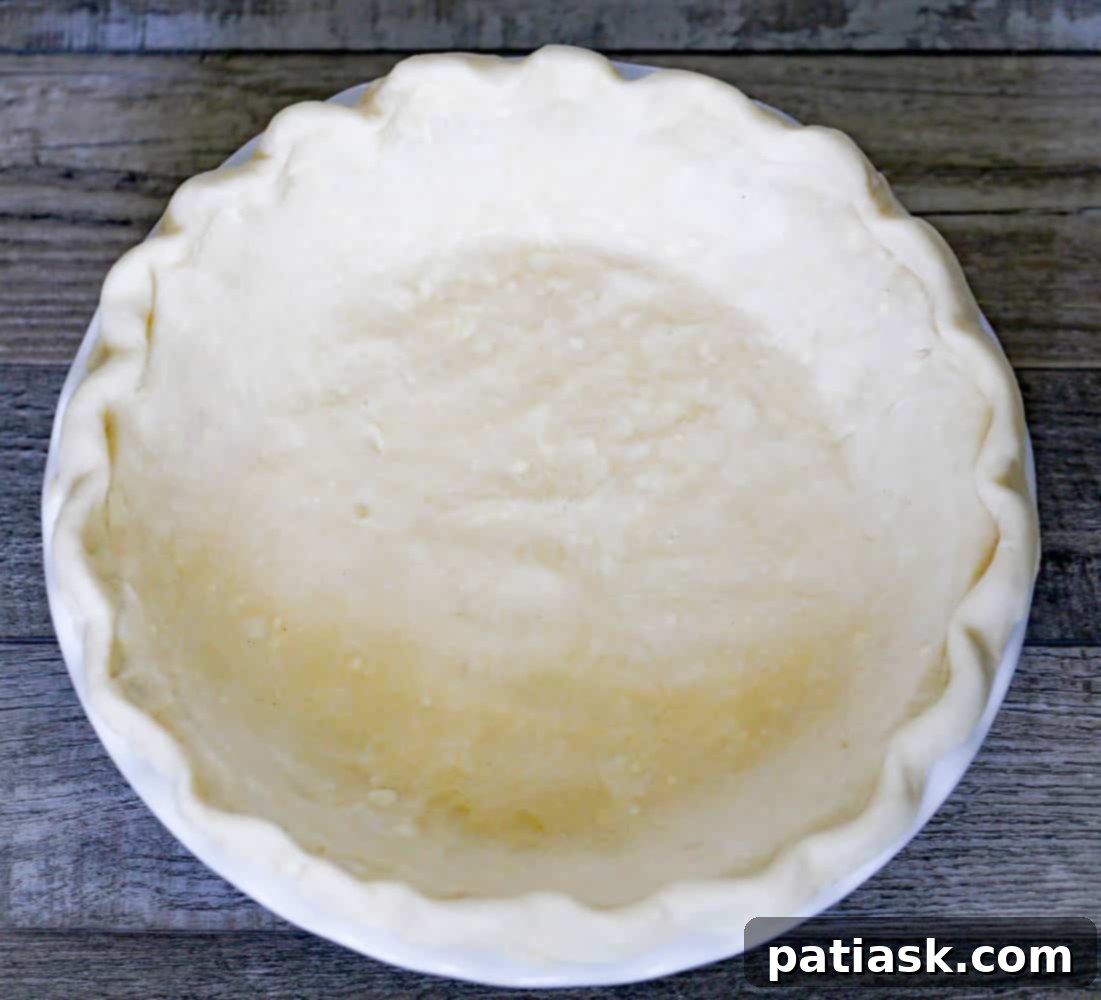
Freezing Your Easy Homemade Pie Crust for Future Delights
One of the many benefits of this homemade pie crust recipe is its freezer-friendliness. Preparing extra crusts in advance can save you significant time when a pie craving strikes or holiday baking demands increase.
- Once you’ve shaped and fluted your pie shell, overwrap it thoroughly with two layers of plastic wrap to prevent freezer burn. You can also place it in a large freezer bag. Freeze the pie shell until you’re ready to use it.
- When you need a frozen shell, transfer it to the refrigerator to thaw overnight, or leave it at room temperature for an hour or two. The goal is for the dough, especially the overhang, to become flexible enough to shape without breaking or tearing. You can bake directly from frozen for some applications, but thawing slightly often yields better results for handling and preventing cracks.

Understanding and Executing Blind Baking (Pre-Baking)
Blind baking is a crucial technique for certain types of pies, preventing a soggy bottom crust and ensuring a perfectly crisp base for your fillings. It refers to the process of pre-baking the pie shell either partially or fully before adding the filling.
- Partially Blind-Baked Crusts: Many custard-based or wet-filling pies benefit from partial blind baking. This sets the crust enough to prevent it from becoming soggy while still allowing it to bake further with the filling. Examples include pumpkin pie, creamy custard pie, pecan pie, chess pie, and sweet potato pie. The crust is baked until lightly golden and set, then the filling is added, and the pie is baked to completion.
- Fully Blind-Baked Crusts: For pies where the filling is not baked (e.g., no-bake cream pies, fresh fruit tarts), a fully blind-baked crust is essential. In these cases, the filling is often cooked separately or requires no cooking, and then added to an already crisp, golden-brown pie shell. This ensures the crust is perfectly cooked and ready to hold its delicious contents without any further baking.
The Art of Weighing Down Your Pie Crust
To ensure your pie crust bakes flat and evenly, preventing it from puffing up or sliding down the sides of the pan, weighing it down is essential. This step is critical for achieving a beautifully shaped, sturdy base for your pie.
- After pricking the bottom of your chilled pie shell, carefully line it with parchment paper, a very large coffee filter, or aluminum foil. Gently nudge the lining evenly into the pan, making sure it conforms to the shape of the crust without disturbing your fluted edge. Leave an overhang of the lining on opposite sides; these “wings” will act as handles for easy removal later.
- Place the lined pie pan onto a baking sheet. This provides a stable surface for transferring the pie to and from the oven and catches any potential butter drips, keeping your oven clean.
- Fill the lined pie shell with enough dried beans, uncooked rice, or specialized pie weights to fill it about two-thirds full. Level them out evenly, paying particular attention to pushing them up against the sides of the crust. This ensures the edges don’t slump during baking.
Baking Your Easy Homemade Pie Crust to Perfection
Careful attention to oven temperature and baking time is key to achieving that perfect golden, flaky pie crust. Follow these guidelines for success:
- Before you begin, adjust your oven racks. One rack should be positioned in the bottom third of the oven, and another in the middle.
- Preheat your oven to 375°F (190°C), unless your specific pie recipe indicates otherwise. Adequate preheating is crucial for a consistent bake.
- Always place your pie shell on a baking sheet lined with parchment paper. This not only makes transferring easier but also acts as a safeguard, catching any butter that might leak from the crust during baking, preventing a smoky mess in your oven.
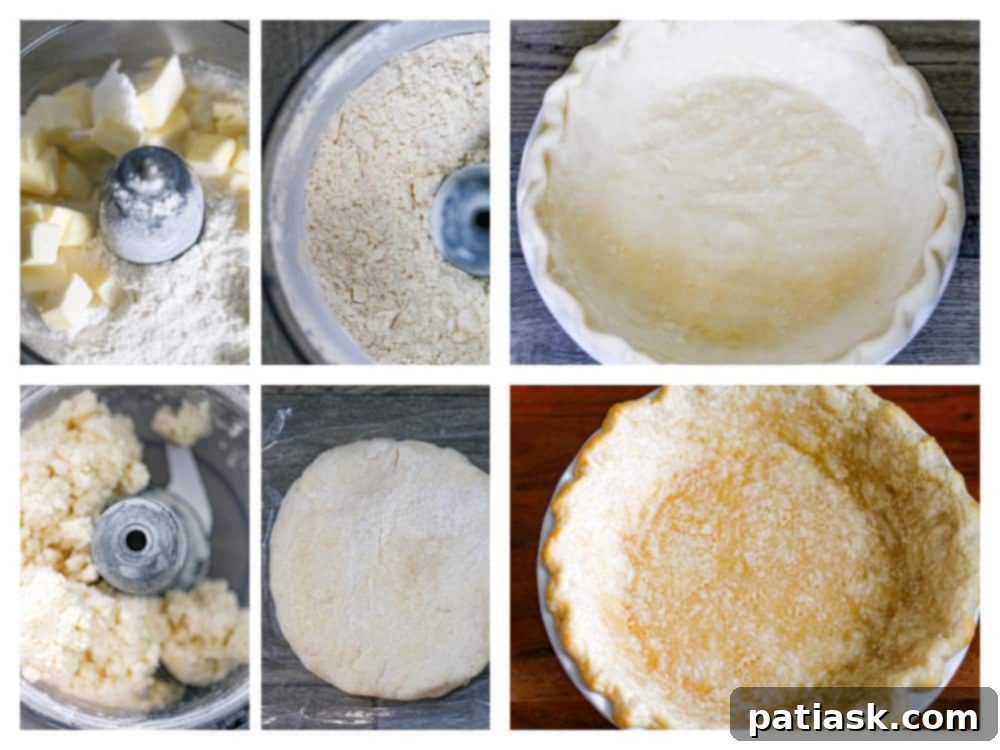
Specific Instructions for Partially Pre-baked Pie Shells
(Ideal for pies like pumpkin, custard, pecan, chess, and sweet potato)
- Bake the weighted pie shell on the bottom rack for a full 25 minutes without opening the oven door. This initial bake sets the crust.
- After 25 minutes, carefully remove the baking sheet from the oven. Gently lift out the foil, coffee filters, or parchment paper with the weights, being careful not to disturb or tear the still-soft crust. Re-poke any holes in the bottom of the crust that may have closed up. These holes are vital for allowing steam to escape and preventing the crust from puffing up during the next stage of baking.
- Return the pie shell to the oven, moving it to the center rack, and reduce the oven temperature to 350°F (175°C). Continue baking for another 10 minutes, again without opening the oven door.
- The crust should have a dry-ish surface, and the top edge should be just beginning to turn a light golden brown. If it needs a little more color, bake for an additional 3-4 minutes, keeping a close watch.
- Once partially baked, the crust is ready for your filling. Add your prepared filling and continue baking according to your pie recipe’s instructions until the pie is fully baked.
Specific Instructions for Fully Pre-baked Pie Shells
(Perfect for cream pies, fresh fruit tarts, and no-bake fillings)
- Bake the weighted pie shell on the bottom rack for a full 25 minutes without opening the oven door.
- After 25 minutes, carefully remove the baking sheet from the oven. Gently lift out the foil, coffee filters, or parchment paper with the weights, taking care not to disturb the crust. Re-poke any holes in the bottom of the crust that may have closed up.
- Return the pie shell to the oven, moving it to the center rack, and reduce the oven temperature to 350°F (175°C). Continue baking for an additional 15-18 minutes, or until the crust is a rich, even golden brown and appears fully cooked and crisp. Again, avoid opening the oven door during this time.
- Once fully baked, transfer the golden pie shell to a wire cooling rack. Allow it to cool thoroughly to room temperature before adding any filling. This prevents condensation and ensures your crust remains crisp.
Pro Tip for Sealing Fully Pre-baked Shells
To prevent your fully pre-baked pie shell from absorbing moisture and becoming soggy, especially with wet or creamy fillings, a quick sealing step can make all the difference:
- Remember those fork pricks you made in the bottom of the crust? For an ingenious seal, smear the tiniest amount of cream cheese into those holes. It acts like a culinary putty, creating a barrier against moisture from your fillings, similar to how spackle fills a tiny nail hole. This trick is particularly effective for very wet fillings.
- Alternatively, you can brush the entire inner surface of the hot pie shell with a lightly beaten egg white immediately after it comes out of the oven. The residual heat will cook the egg white into a thin, invisible layer that creates a protective barrier, sealing the crust from moisture. This method is quick, easy, and provides an excellent seal.
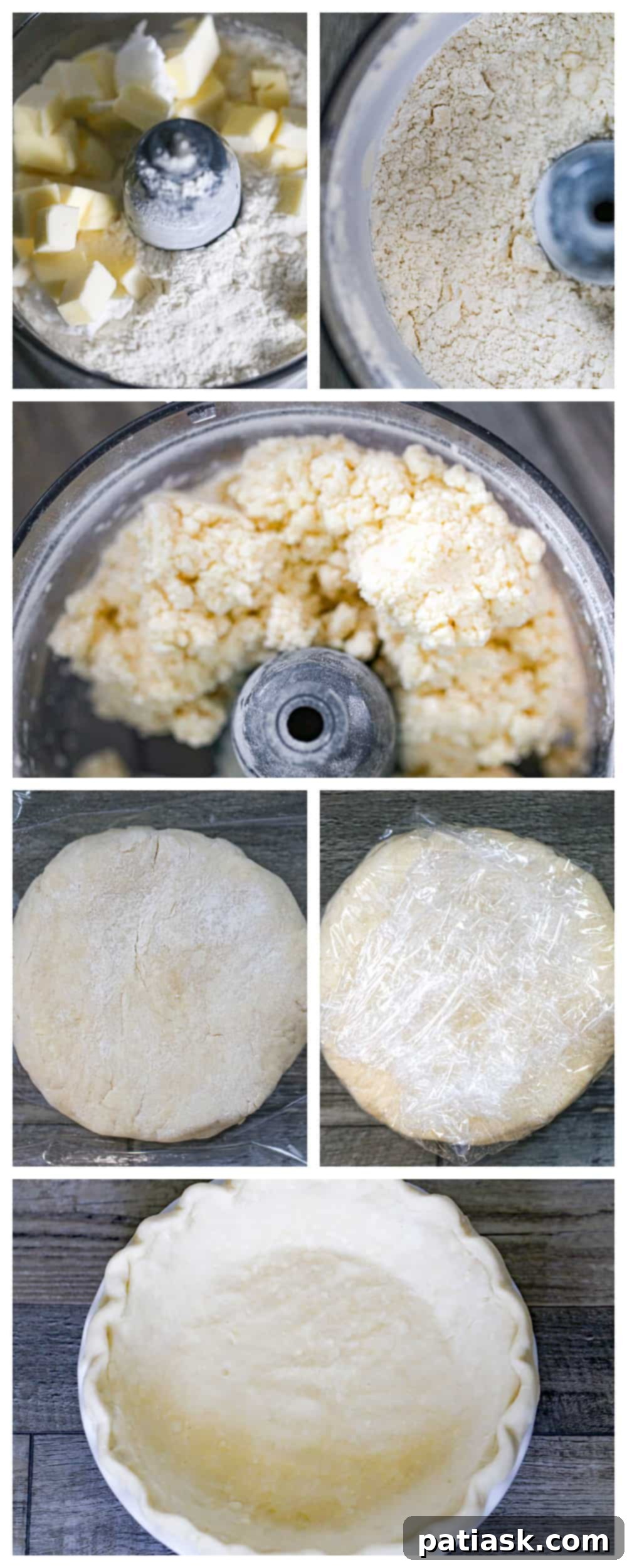
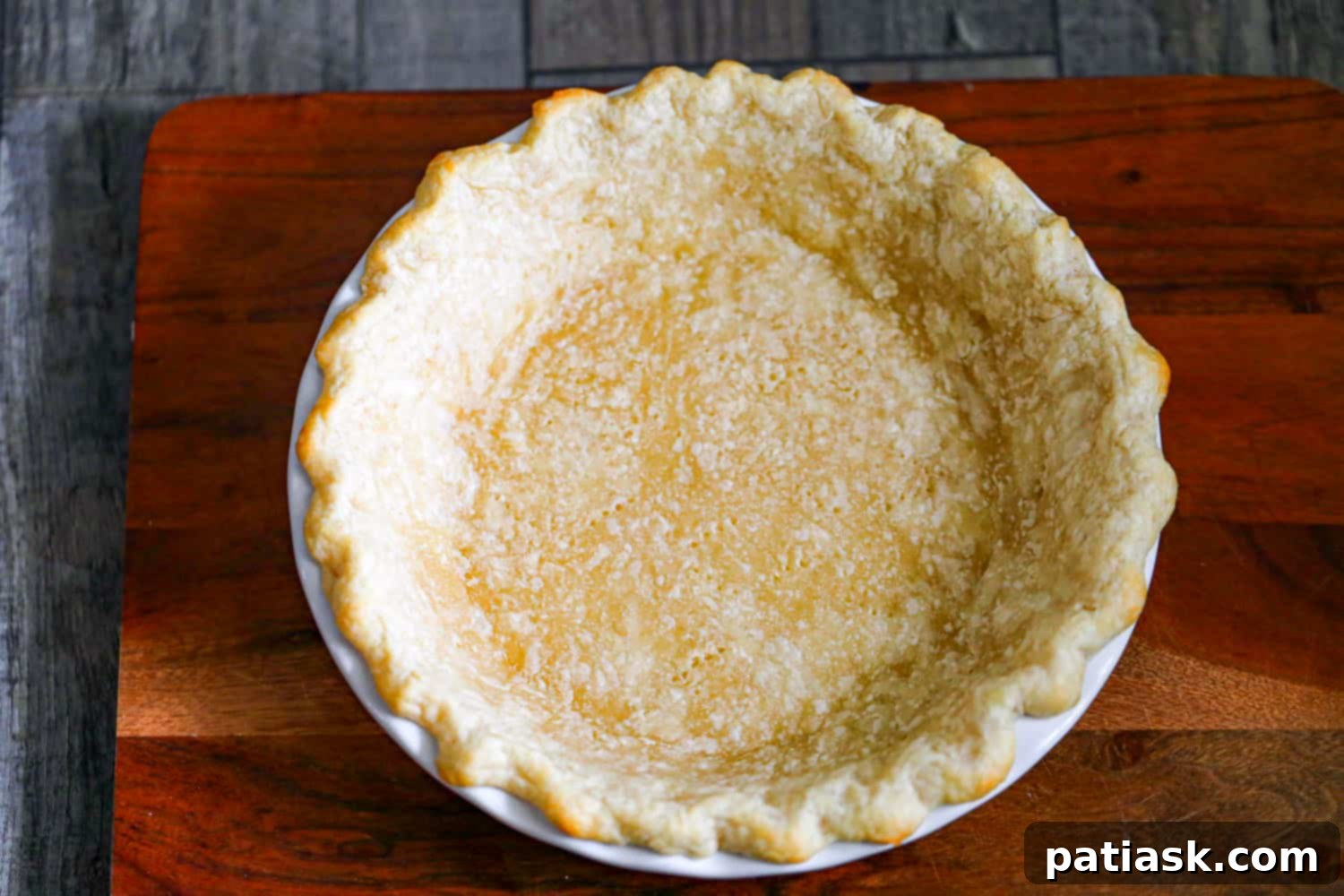
Making homemade dough for a pie crust might initially seem like a formidable challenge. But with this easy homemade pie crust recipe, achieving a tender, flaky, and beautifully golden crust from the comfort of your own home is not only possible but easier than ever. You’ll impress yourself and everyone you share your creations with!
Now that you feel confident and equipped with this comprehensive pie knowledge, it’s time to roll up your sleeves and bake up this incredible homemade pie crust recipe. Get ready to create some glorious pies that will become cherished family favorites!
Holiday & Dessert Pie Inspirations
- 15 Popular Easy Cream Pies You’ll Love!
- Key Lime Cheesecake Pie
- Chocolate Heaven Magic Custard Cake
- Pecan Cheesecake Pie
- The Perfect Cheesecake Experience
- 12 Delectable Pies for the Holidays!
- Ultimate Chocolate Cookies
- 21 Dreamy Cream Pies To Go Ga-Ga Over!
- Raspberry Vanilla Custard Pudding Pie
- Super Easy Homemade Brownies
- Amish Country Pumpkin Custard Pie
- Pretzel Pie Crust
Easy Homemade Pie Crust
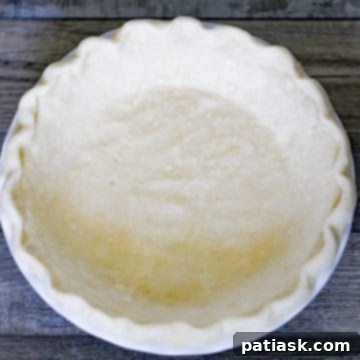
Our easy, delicious homemade pie crust offers a pretty golden color, tender, flaky layers, and rich buttery flavor. If you’ve been intimidated by baking pie dough from scratch, our foolproof food processor method makes this dough super easy to work with and guarantees a beautifully baked crust every time!
Course: Dessert
Ingredients
- 1 ½ cups all-purpose flour
- 1 ½ teaspoons cornstarch
- ½ teaspoon salt
- 8 tablespoons unsalted butter, cut into ½ inch cubes (For an all-butter crust, omit shortening and use 10 tablespoons butter)
- 2 tablespoons Crisco shortening or lard
- 2 teaspoons white vinegar
- Scant ⅓ cup ice-cold water
Instructions
To Start:
- Whisk together the flour, cornstarch, and salt in a small bowl.
- Place butter and Crisco cubes on a plate dusted with flour.
- Measure the cold water and add the vinegar to it.
- Place everything in the fridge for 10-15 minutes to chill thoroughly.
Making the Crust:
- Transfer the dry ingredients to the food processor. Add the butter/Crisco, then pulse the machine 6-7 times until the pieces of fat are roughly the size of small peas.
- Pour the vinegar-water mixture through the feed tube in a 7-8 second stream, pulsing the machine as you add it. Stop pulsing when the mixture just starts to form larger clumps.
- Turn the dough out onto your work surface and pack it into a ball. Place the dough on a sheet of plastic wrap and flatten it into a ¾ inch thick disc. Wrap the disc and refrigerate for at least one hour before rolling.
Flatten & Roll the Dough:
- Dust your work surface with flour before you begin rolling the dough. Dust the top of the dough and the rolling pin as needed to prevent sticking.
- Rock over the dough a few times with your rolling pin and begin rolling it from the center out. Give the dough a quarter turn, then repeat the rolling sequence. Roll the dough out into a 12-13 inch circle using medium pressure.
- For deep dish pies, aim for 12 ½ to 13 inches in diameter. For standard 9 – 9 ½ inch pie pans, a 12-inch circle will suffice.
- If there’s any lingering flour on the dough once it’s rolled out, take a pastry brush and quickly brush the excess flour off, as the dough becomes more difficult to handle the longer it stays at room temperature.
Turn the Dough into the Pie Pan:
- Simply run your hands under the dough, then lift it into the pan without stretching or tearing. Alternatively, roll the dough onto your rolling pin, position the pin over one edge of the pan, then unroll the dough into the pan.
- Ensure the dough is draped evenly over the pan. Gently nudge the dough down the sides and crease at the bottom. Work your way around gradually. You want an overhang of about ½ inch to ¾ inch all around. Trim with scissors to get a nice even cut.
To Flute the Edge:
- Starting anywhere along the edge, take the overhanging dough and fold it under toward the outside of the pan so any seam is hidden. As you fold, pinch the dough together while you sculpt it into an upright ridge ½ to ¾ inches high. Work your way around the edge until complete.
- Place the shell into the freezer for 5-6 minutes to firm up the ridge. This helps the flutes to hold their shape easier.
- To create the flute, form a V with the thumb and forefinger of one hand against the outside of the rim. With your other forefinger or thumb, press against the shell from the other side, pushing the dough into the V. Continue around the perimeter. Cover with plastic wrap and refrigerate the shell for 15 minutes minimum before filling or blind-baking.
- If you need to prebake the shell, poke the bottom 7-8 times with a fork. When you poke, twist the fork slightly to enlarge the holes, as small holes tend to close up during pre-baking. This vents steam and prevents puffing.
Blind Baking:
- Blind baking refers to the process of pre-baking the pie shell either partially or fully to set the crust and keep it crisp. Pies that benefit most from partial pre-baking include pumpkin, custard, pecan, chess, and sweet potato. Certain pie shells need to be fully pre-baked when no further baking is needed for the pie, most notably cream pies, where the filling is cooked separately and then added to the shell.
To Weigh Down the Crust:
- The first step is to weigh down the crust so it doesn’t balloon up in the oven. If it puffs up, it may not brown properly and can become misshapen, failing to hold the filling correctly.
- Line the shell with foil, very large coffee filters, or parchment paper by nudging it evenly into the pan without disrupting the pie shell. Leave an overhang on opposite sides as “wings” for easy removal. Place the pie pan onto a baking sheet lined with parchment paper. Add enough dried beans or pie weights (about two-thirds full), and level them out evenly, especially up and around the sides.
Baking the Pie Crust:
- Before baking, adjust oven racks (one bottom, one middle). Preheat oven to 375°F (190°C). Place your pie shell on a parchment-lined baking sheet to catch any leaking butter and prevent messes.
- For Partially Pre-baked Pie Shells (pumpkin, custard, pecan, chess, sweet potato): Bake for 25 minutes on the bottom rack. Carefully remove weights and lining. Re-poke any closed holes. Move to the center rack, reduce heat to 350°F (175°C), and bake for another 10 minutes until the surface is dry-ish and edges are light golden. If needed, bake 3-4 minutes longer. Add filling and continue baking per recipe.
- For Fully Pre-baked Pie Shells (cream pies): Bake for 25 minutes on the bottom rack. Carefully remove weights and lining. Re-poke any closed holes. Move to the center rack, reduce heat to 350°F (175°C), and bake for an additional 15-18 minutes until golden brown and crusty. Cool thoroughly on a cooling rack before filling.
Notes
- Pro Tip for Sealing Fully Pre-baked Shells: To prevent moisture from fillings, smear a tiny amount of cream cheese into the fork holes, or brush the entire surface with a lightly beaten egg white immediately after the pie comes out of the oven.
- For double crust or lattice pies: Double this recipe. Divide the dough in half, making one half slightly larger for the bottom crust.
- Storage: Pie dough can be refrigerated for up to 3 days (well-wrapped in plastic). Unbaked pie shells can also be refrigerated for up to 3 days.
Keyword: baking, pie, pie crust
Tried This Recipe? Let us know how it was by commenting below!
Recipe adapted from Pie Academy: Master the Perfect Crust by Ken Haedrich.
